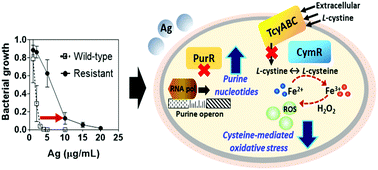Our official English website, www.x-mol.net, welcomes your feedback! (Note: you will need to create a separate account there.)
Heritable nanosilver resistance in priority pathogen: a unique genetic adaptation and comparison with ionic silver and antibiotics.
Nanoscale ( IF 6.7 ) Pub Date : 2020-01-13 , DOI: 10.1039/c9nr08424j Elizabeth Valentin 1 , Amy L Bottomley 1 , Gayatri S Chilambi 2 , Elizabeth J Harry 1 , Rose Amal 3 , Georgios A Sotiriou 4 , Scott A Rice 5 , Cindy Gunawan 6
Nanoscale ( IF 6.7 ) Pub Date : 2020-01-13 , DOI: 10.1039/c9nr08424j Elizabeth Valentin 1 , Amy L Bottomley 1 , Gayatri S Chilambi 2 , Elizabeth J Harry 1 , Rose Amal 3 , Georgios A Sotiriou 4 , Scott A Rice 5 , Cindy Gunawan 6
Affiliation

|
The past decade has seen the incorporation of antimicrobial nanosilver (NAg) into medical devices, and, increasingly, in everyday 'antibacterial' products. With the continued rise of antibiotic resistant bacteria, there are concerns that these priority pathogens will also develop resistance to the extensively commercialized nanoparticle antimicrobials. Herein, this work reports the emergence of stable resistance traits to NAg in the WHO-listed priority pathogen Staphylococcus aureus, which has previously been suggested to have no, or very low, capacity for silver resistance. With no native presence of genetically encoded silver defence mechanisms, the work showed that the bacterium is dependent on mutation of physiologically essential genes, including those involved in nucleotide synthesis and oxidative stress defence. While some mutations were uniquely associated with resistance to NAg, the study also found common mutations that could be protective against both NAg and ionic silver. This is consistent with the observation of NAg/ionic silver cross-resistance. These mutations were detected following withdrawal of the silver exposure, denoting heritable characteristics that allow for spread of the resistance traits even with discontinued silver use. Heritable silver resistance in priority pathogen cautions that these nanoparticle antimicrobials should only be used as needed, to preserve their efficacy for treating infections.
中文翻译:

优先病原体中可遗传的纳米银抗性:独特的遗传适应性以及与离子银和抗生素的比较。
在过去的十年中,已经将抗菌纳米银(NAg)掺入医疗设备,并且越来越多地掺入日常的“抗菌”产品中。随着抗生素抗性细菌的持续增加,人们担心这些优先病原体还将对广泛商业化的纳米颗粒抗微生物剂产生抗性。本文中,这项工作报告了在WHO列出的优先病原体金黄色葡萄球菌中出现了对NAg的稳定抗药性,以前已提出该抗性不具有或具有非常低的银抗性。由于没有天然存在的基因编码的银防御机制,这项工作表明该细菌依赖于生理必需基因的突变,包括与核苷酸合成和氧化应激防御有关的基因。尽管某些突变与对NAg的抗性具有独特的关联,但该研究还发现了可能对NAg和离子银均具有保护作用的常见突变。这与观察到的NAg /离子银交叉电阻是一致的。在退出银暴露后检测到这些突变,这表示可遗传的特征,即使不连续使用银也允许耐药性状的传播。优先病原体中可遗传的银抗性提示,这些纳米颗粒抗微生物剂应仅在需要时使用,以保持其治疗感染的功效。在退出银暴露后检测到这些突变,这表示可遗传的特征,即使不连续使用银也允许耐药性状的传播。优先病原体中可遗传的银抗性提示,这些纳米颗粒抗菌剂仅应在需要时使用,以保持其治疗感染的功效。在退出银暴露后检测到这些突变,这表示可遗传的特征,即使不连续使用银也允许耐药性状的传播。优先病原体中可遗传的银抗性提示,这些纳米颗粒抗菌剂仅应在需要时使用,以保持其治疗感染的功效。
更新日期:2020-01-13
中文翻译:

优先病原体中可遗传的纳米银抗性:独特的遗传适应性以及与离子银和抗生素的比较。
在过去的十年中,已经将抗菌纳米银(NAg)掺入医疗设备,并且越来越多地掺入日常的“抗菌”产品中。随着抗生素抗性细菌的持续增加,人们担心这些优先病原体还将对广泛商业化的纳米颗粒抗微生物剂产生抗性。本文中,这项工作报告了在WHO列出的优先病原体金黄色葡萄球菌中出现了对NAg的稳定抗药性,以前已提出该抗性不具有或具有非常低的银抗性。由于没有天然存在的基因编码的银防御机制,这项工作表明该细菌依赖于生理必需基因的突变,包括与核苷酸合成和氧化应激防御有关的基因。尽管某些突变与对NAg的抗性具有独特的关联,但该研究还发现了可能对NAg和离子银均具有保护作用的常见突变。这与观察到的NAg /离子银交叉电阻是一致的。在退出银暴露后检测到这些突变,这表示可遗传的特征,即使不连续使用银也允许耐药性状的传播。优先病原体中可遗传的银抗性提示,这些纳米颗粒抗微生物剂应仅在需要时使用,以保持其治疗感染的功效。在退出银暴露后检测到这些突变,这表示可遗传的特征,即使不连续使用银也允许耐药性状的传播。优先病原体中可遗传的银抗性提示,这些纳米颗粒抗菌剂仅应在需要时使用,以保持其治疗感染的功效。在退出银暴露后检测到这些突变,这表示可遗传的特征,即使不连续使用银也允许耐药性状的传播。优先病原体中可遗传的银抗性提示,这些纳米颗粒抗菌剂仅应在需要时使用,以保持其治疗感染的功效。



























 京公网安备 11010802027423号
京公网安备 11010802027423号